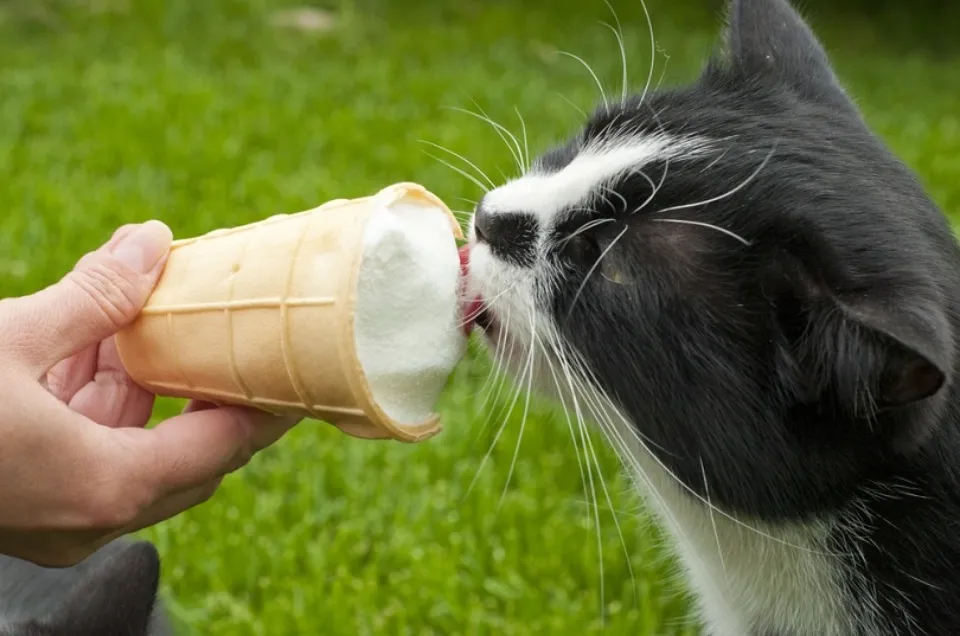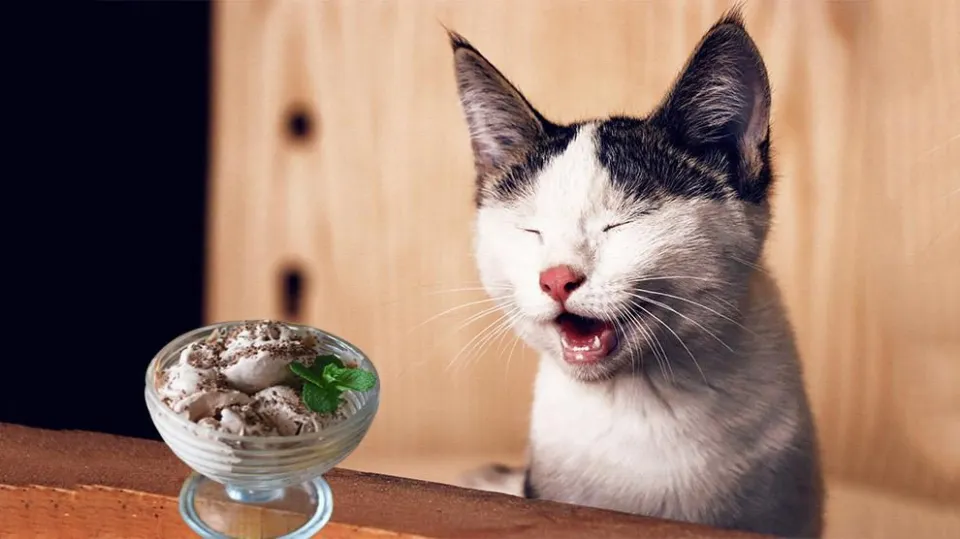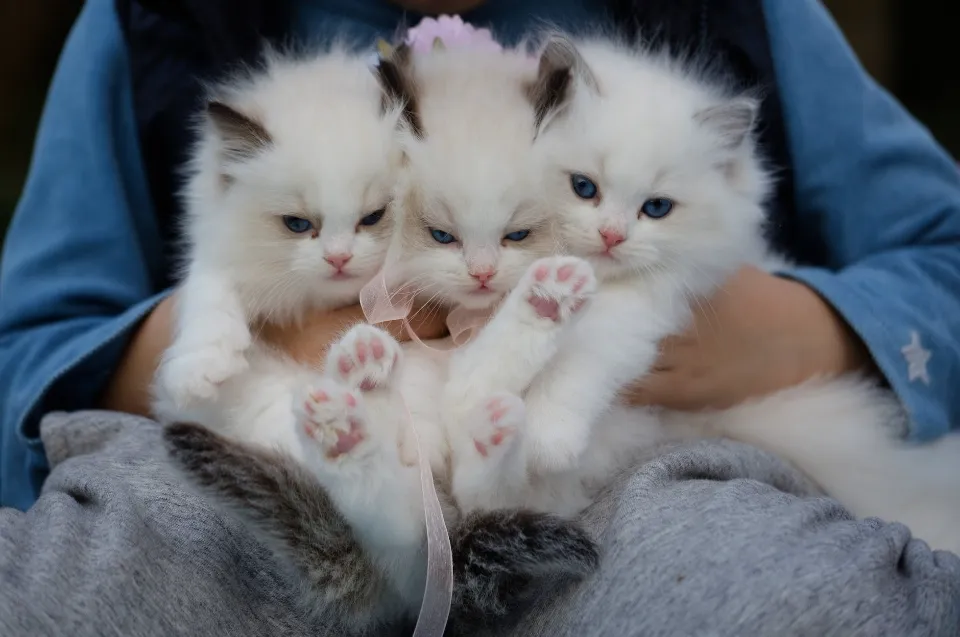The effects of vanilla ice cream on cats will be discussed in detail in this article. You will gain knowledge of how to handle a situation like this way.
Owners of cats might be enticed to give their feline companions a scoop of delicious and cooling vanilla ice cream during the summer’s sweltering days. The idea that cats enjoy drinking milk is common, so why would ice cream be any different? Vanilla ice cream is edible to cats in moderation. Generally, vanilla ice cream isn’t harmful to cats, however, lactic acid can cause stomach aches, gas, and diarrhea in cats if ingested in high amounts.
Let’s examine this topic in more detail. All the information you require regarding vanilla ice cream and cats is provided below. Learn Can Dogs Eat Vanilla Ice Cream?
Can Cats Eat Vanilla Ice Creams?
After you’ve finished your bowl of ice cream, it’s okay to let your cat lick the spoon, but you shouldn’t ever give her a lot of vanilla ice cream. Your cat may experience vomiting and diarrhea if they consume too much ice cream, which can seriously upset its digestive system.
Cats can safely consume small amounts of artificial sweetener-sweetened vanilla ice cream. But your cat won’t be overly tempted by a sweet-tasting treat. In fact, felines don’t have any sweet taste receptors and, therefore, will not appreciate sweet-tasting ice cream. Avoid giving your cat any vanilla ice cream that contains any chocolate. Any type of chocolate is fatal to cats and is poisonous.
And if your cat has a lactose intolerance, don’t give her ice cream. Some cats, like some humans, have trouble properly digesting the lactose present in dairy products.

Why is Too Much Vanilla Ice Cream Bad for Cats?
As mentioned before, a little lick shouldn’t be the cause of panic. But you should definitely refrain from giving your cat a lot of ice cream. Considering that you can read more about this tasty treat by scrolling down, it does contain a lot of sugar as well as artificial sweeteners like Xylitol.
Propylene Glycol
These two words, though they may seem like something you skip because you don’t even want to try to read them, are crucial when discussing the reasons why cats can’t eat vanilla ice cream.
You see, propylene glycol is a “safe” antifreeze that’s typically used to prevent ice crystals from developing in your ice cream. While that’s great and all, propylene glycol can poison cats. Even using it in cat food is now prohibited.
The symptoms that your feline friend may experience if she consumes too much of something containing this ingredient include weakness, loss of appetite, fever, skin discolorations, urine discolorations, and fever.
Furthermore, if untreated, these symptoms may lead to anemia, particularly Heinz body anemia, or even irreparable harm to your cat’s nervous system.
Lactose
You probably didn’t expect to learn this, but cats cannot tolerate lactose. The lactase enzyme is absent from the digestive systems of the majority of cats. It is in charge of processing and dissolving lactose found in common dairy products.
Whole milk, the dairy product that contains the most lactose of all dairy products, is typically used to make vanilla ice cream. What occurs if your lactose-intolerant cat consumes a large quantity of vanilla ice cream?
Well, diarrhea, vomiting, and upset stomach are the most typical symptoms. Even though those signs don’t sound as serious as damage to your cat’s nervous system, they’re still pretty uncomfortable.

So, the next time you intend to devour a whole bucket of ice cream in front of your curious animal, you might want to choose dairy-free ice cream instead. Or you can completely forego this tasty treat.
Vanilla
Even though we have already discussed this in one of the earlier paragraphs, it doesn’t hurt to do so once more. Cats are thought to be toxic to vanilla extract, which is typically found in vanilla ice cream.
Alcohol poisoning is a common consequence of ethanol, one of the key components of vanilla extract. It goes without saying that you don’t want your furry friend to become ill from alcohol poisoning.
She wouldn’t actually need to consume much more than a teaspoon of ethyl alcohol to show any signs of alcohol poisoning, but it’s still better to be safe than sorry.
What to Do If Your Cat Ate Vanilla Ice Cream?
It isn’t much you can do about it because cats cannot die from eating vanilla ice cream. Naturally, if your pet consumes a lot of food and begins to exhibit some symptoms, you should exercise caution. If such is the case, you can do the following:
Observe Your Cat
After eating vanilla ice cream, you should watch your cat and look for any complications. To determine if your pet is okay, keep an eye out for even the smallest issues. Some symptoms would indicate danger, and if this were the case, you might need to make a phone call or take your pet to the closest veterinarian. Vomiting and pain are a couple of them.
Prevent Your Pet from Eating More Ice Cream
Having your pet consume more of it is the last thing you need. As a result, you should confine your pet to an area free of any edible objects. It’s likely that your pet snuck into the kitchen and ate some ice cream if you didn’t offer it to them. It should therefore be a reminder never to leave any ice cream unattended.

Understand What Happened
Make a note of every fact you can find about the incident. It will be useful when you take your animal to the veterinarian. You must respond to and comprehend the following inquiries regarding the scene.
- The amount of ice cream your cat consumed
- Does the ice cream contain harmful ingredients like xylitol?
- How much time has passed since it occurred?
A better understanding of the incident’s severity would be provided by receiving such information. Additionally, if you visit the vet and inquire about what transpired, it will assist you in reporting what happened.
Take Your Pet to Your Vet
The other ice cream ingredients specifically may hurt your pet, even though the vanilla won’t.
Due to this, it would be best to call your veterinarian and fully describe the incident. Definitely, you’ll be asked to bring your pet in to be examined by them. You will be prompted to provide all the details your veterinarian requires. You must be fully informed about the incident for this reason.
What Ice Cream Can Cats Eat?
You can choose vanilla flavor ice cream if your cat wants it. The best way to make sure your cat doesn’t have digestive problems is to give her ice cream made from goat’s milk.
Reduce the sugar slightly if you make your own. Xylitol is a sugar substitute that has no effect on cats. The eggs should be thoroughly beaten before being cooked with the milk until it reaches a simmer if you want your homemade ice cream to have a more custard-like consistency. Before adding to the mixture, give it a little time to cool.
Strawberry ice cream is also acceptable in moderation. Although they are nontoxic, strawberries have very little to no nutritional value for cats.
Conclusion: Can Cats Eat Vanilla Ice Creams?
Once more, your cat shouldn’t be harmed by taking a lick of vanilla ice cream. If you do plan to give your cat vanilla ice cream (or ice cream of any type) consider the following:
- Give them a non-dairy form of ice cream
- Feed your cat ice cream free of additives, sugars, or high salt content
- Feed your cat vanilla icecream in extremely limited quantities
If feeding her ice cream worries you, you can always offer her some plain, low-fat yogurt or sour cream instead. You can buy a lot of ice cream substitutes, I assure you.
FAQs
Is It OK to Give Cats Ice Cream?
Ice cream has no nutritional value for cats, so it is not advised. While small amounts are unlikely to make your cat ill, larger portions can cause stomach problems.
Why Does My Cat Like Vanilla Ice Cream?
Ice cream is made with milk after all, and kitties love that milk. Since cats are unable to taste the sweetness and are unconcerned by it, the sweetness has no bearing on them. They’re interested in the milk.


